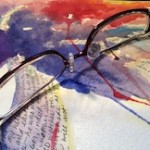“I only write when I am
inspired. Fortunately I am inspired at 9 o’clock every morning.” -William Faulkner
There once was a time when I thought I could only write when I was depressed. This did not bode well for my writing career–or maybe for my future mental health. Thankfully, I have since found I can indeed write in any kind of mood. It is a matter of sitting down and doing it. Granted, sometimes it turns out better than others, sometimes I end out deleting everything the following day, but even that is a sort of priming the pump. As John Cleese mentioned in his speech about creativity, sometimes in order to know what an elephant is, you have to chisel away the non-elephant parts.
For the most part, I have found that inspiration comes AFTER I’ve sat down and started writing. It is the act of writing–or painting or drawing or whatever–that brings about the desired inspiration. As Michael  Michalko says in his post, Twelve Things You Were Not Taught in School About Creativity,
Michalko says in his post, Twelve Things You Were Not Taught in School About Creativity,
3. You must go through the motions of being creative. When you are producing ideas, you are replenishing neurotransmitters linked to genes that are being turned on and off in response to what your brain is doing, which in turn is responding to challenges. When you go through the motions of trying to come up with new ideas, you are energizing your brain by increasing the number of contacts between neurons. The more times you try to get ideas, the more active your brain becomes and the more creative you become. If you want to become an artist and all you did was paint a picture every day, you will become an artist. You may not become another Vincent Van Gogh, but you will become more of an artist than someone who has never tried.
How many times do we put limitations on ourselves and our creativity? We can only paint if we are happy, we can only compose if we are “in the mood”, we can only write at night, or in the morning, or when we are drunk. The list goes on. Yup, there is no magic formula on when or how to be creative, but the more we try it, the more chance we have at discovering the elephant and not just the “not-elephant.”
Number 10 in Michael Michalko‘s post is “You do not see things as they are; you see them as you are.” I love this point even though it can be both good and bad. Take the idea that I can only write when I am depressed. This is not true, but if I see it that way and only sit down to write when I am depressed, bingo! Self-fulfilling prophecy. On the flip side, this is what makes each of us creative. I can write a novel about–oh, let’s say a dystopia since that is particularly big right–and yet still make it unique. So go ahead and write, draw, paint, compose the piece that only YOU can create.
Be inspired.



Pingback: Celebration of ART | WorldWalkings
In relation to “going through the motions”. I took a copywriting course that recommended copying (by hand) the advertisements that most inspire you. I’ve since found advertising generally doesn’t inspire me, but am trying to copy some of the fiction that has inspired me (typing) and found that it is an interesting process. I have to go slower when typing than when reading and so find myself paying more attention to what the author was doing – how they develop the characters, or where the foreshadowing is, and even stupid stuff like how long is the average chapter or scene. It seems to be a good warm up for writing my own stuff.
Another project that I’ve found helpful for increasing creativity is to rewrite a familiar story with a twist. (Lately, that’s been trying to tell fairy tales in a modern setting… but you could go so many ways with that starting point.)
This is a great idea. Sometime I re-read, telling myself to pay attention to what the author is doing. But if it’s a good book, I always end out just reading. I’ll have to try the re-writing. In the book How to write a sentence and how to read one, Stanley Fish talks about re-writing sentences and then trying to write a sentence in the same style as the one you rewrote. Good practice.